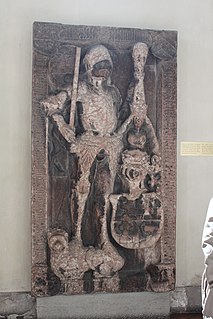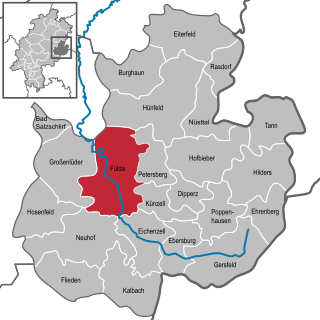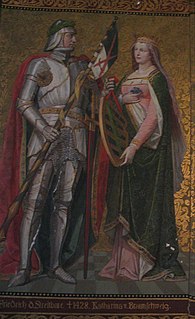| William II of Henneberg-Schleusingen | |
|---|---|
| Born | 14 March 1415 |
| Died | 8 January 1444 (aged 28) |
| Noble family | House of Henneberg |
| Spouse(s) | Catherine of Hanau |
| Father | William I, Princely count of Henneberg-Schleusingen |
| Mother | Anna of Brunswick |
William II of Henneberg-Schleusingen (born: 14 March 1415; died: 8 January 1444, [1] killed in a hunting accident) was the second husband of Catherine of Hanau (born: 25 January 1408; died: 25 September 1460). She was the oldest daughter of Reinhard II, Count of Hanau and his wife Catherine of Nassau-Beilstein and had earlier been married to Count Thomas II of Rieneck. William II and Catherine were engaged on 17 May 1432. She signed away her legal claims against the County of Rieneck in June 1432, in exchange for 8000florins. From William, she received a dowry of 16000florins, which were secured by the district and castle of Mainberg, near Schweinfurt.

Reinhard II of Hanau was Lord of Hanau and from 1429 Count of Hanau. He was one of the most important member of the House of Hanau.
A dowry is a transfer of parental property, gifts or money at the marriage of a daughter. Dowry contrasts with the related concepts of bride price and dower. While bride price or bride service is a payment by the groom or his family to the bride's parents, dowry is the wealth transferred from the bride's family to the groom or his family, ostensibly for the bride. Similarly, dower is the property settled on the bride herself, by the groom at the time of marriage, and which remains under her ownership and control. Dowry is an ancient custom, and its existence may well predate records of it. Dowries continue to be expected and demanded as a condition to accept a marriage proposal in some parts of the world, mainly in parts of Asia, Northern Africa and the Balkans. In some parts of the world, disputes related to dowry sometimes result in acts of violence against women, including killings and acid attacks. The custom of dowry is most common in cultures that are strongly patrilineal and that expect women to reside with or near their husband's family (patrilocality). Dowries have long histories in Europe, South Asia, Africa and other parts of the world.
Amt is a type of administrative division governing a group of municipalities, today only in Germany, but formerly also common in other countries of Northern Europe. Its size and functions differ by country and the term is roughly equivalent to a US township or county or English shire district.
Princely count William II died after a hunting accident, which happened on the evening of New Year's Day 1444: a wild boar, which he tried to kill with his sword, wounded him so severely that he died a few days later.
William and Catherine had the following children:
- William III, Princely count of Henneberg-Schleusingen (born: 12 March 1434; died: 26 May 1480), married to Duchess Margaret of Brunswick-Wolfenbüttel (born: 1451, died: 13 February 1509)
- Margaret (1437-1491), a nun in the convent at Ilm
- John III (born: 2 July 1439; died: 20 May 1513), abbot of the monastery of Fulda
- Berthold XII (born: 9 January 1441), clergyman
- Berthold XIV (born: 4 March 1443; died: 20 April 1495), provost of Bamberg
- Margaret (born: 10 October 1444; died: 3 March 1485), married to Count Günther XXXVI of Schwarzburg-Blankenburg (d. 1503)

Princely count William III of Henneberg-Schleusingen was a member of the House of Henneberg. He was the son of William II of Henneberg and Catherine of Hanau. William III inherited the princely county of Henneberg in 1440, when his father died in a hunting accident. In 1469, he married Margaret, the daughter of Duke Henry the Peaceful of Brunswick-Lüneburg.

The Ilm is a 128.7 kilometers (80.0 mi) long river in Thuringia, Germany. It is a left tributary of the Saale, into which it flows in Großheringen near Bad Kösen.

Fulda is a city in Hesse, Germany; it is located on the river Fulda and is the administrative seat of the Fulda district (Kreis). In 1990, the town hosted the 30th Hessentag state festival.








